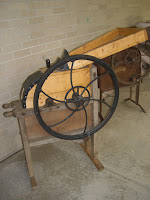Isaac's interest in photography is mentioned in his journal several times during 1871, and when he sold his drug store business, he considered becoming a photographer--if not a professional then at least an amateur. With the changes occurring as towns sprung up on the prairie and railroad tracks slashed through the landscape, Isaac dreamed of preserving images of the unspoiled country before it was "ruined" by civilization.
He believed there would be a particular market for stereoscope views, photographing not only the landscape but also public occasions and seasonal images to be enjoyed at other times of the year. Stereoscope views consist of a pair of images taken by cameras a few feet apart, with the finished photographs mounted side-by-side on a rectangular cardboard. Inserted in the adjustable rack of the stereoscope, when the pair of images are viewed through the lenses of the stereoscope, the two photographs merge into a 3-dimensional image. In a world before television, movies and computers, stereoscopes provided both entertainment and the opportunity to view distant places.
Isaac studied the various types of cameras available, of which there were several, and just as today, the prices varied widely. Although these cameras were expensive, in comparison to the amounts Isaac had spent on his library, a camera seemed affordable. However, having sold his business, he may no longer have been in the position to purchase such luxuries, and it is uncertain whether Isaac bought his own camera.
A journal entry during the summer of 1890, two decades after the first entries about photography, it became obvious that Isaac's interest had not disappeared, for he wrote: "...very anxious to have a series of Negatives taken of my home from several points of view." The following day he added, "I walked over place with small mirror selecting point of views to photo, some time, making some 30 different interesting views I would like to have taken."
As if fate had heard Isaac's wishes, only four days later at a political rally in Pratt Center, Isaac met Seth Blake, a farmer with an amateur photo outfit. Blake lived only 7 miles south of Isaac, and they struck up a friendship. In the following months, Isaac accompanied Blake to several political rallies to photograph the events, and Blake began coming to Isaac's farm to photograph his neighbors, using Isaac's picturesque farm setting as a back drop.
Among the neighbors Isaac recorded as having been photographed at his farm were the William Campbell family, Fracks, Frank Curtis team and women, William Blanch family, Graff and Penrose in buggy, Carr team and wagon, Sadie and children, Mrs. Henn and family, Miss Anna Carr and Miss Balser, Mrs. Ross, McHenry team, and numerous other photographs of boys on horses and groups that were not specifically identified. The hard times had reduced the farms of many neighbors to abject poverty, and I suspect there are many photographs in family albums with Isaac's prosperous farm and beautiful tree groves in the background, assumed by descendants to be their ancestors' farms. I have yet to locate any photographs of such family groups, nor the historically valuable images of political rallies and parades that Blake and Isaac took. Neither have I found the photographs of Isaac's farm, his 3-horse cultivator, nor the co-operative potato patch, all of which are mentioned in his journal.
The cameras of that time were cumbersome and heavy; yet, Isaac describes in his journal the day he climbed into the top of his big cottonwood tree with one of Blake's cameras in an attempt to photograph an elevated view of his farm. Imagine Isaac, at the age of forty-five, perched high in a cottonwood tree! He concluded that the wind in the tree caused too much swaying to get a good image, and he climbed down without getting his photograph.
I remain hopeful that some of these photographs still exist for me to find. Seth Blake did not develop his own dry plate negatives, which were developed by a studio in Pratt (probably Logan's) and by Miss Shira in St. John, so some of Isaac and Blake's photographs may appear on mounting cardboard bearing the logo or address of these or other studios.
I also know that Isaac sat for two different studio portraits of himself in 1890 and 1891, taken at Logan and Shira's studios. He recorded having sent studio portraits to his siblings, as well as some photographs of his farm, but if they still exist, I have not located them.
I have made the most surprising discoveries in doing research for the book, so I continue to hope that I may yet find one of Isaac's photographs!















